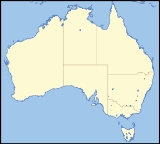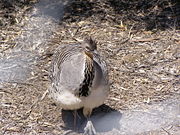
Mallee Cliffs National Park
Encyclopedia



National park
A national park is a reserve of natural, semi-natural, or developed land that a sovereign state declares or owns. Although individual nations designate their own national parks differently A national park is a reserve of natural, semi-natural, or developed land that a sovereign state declares or...
in the south-west of New South Wales
New South Wales
New South Wales is a state of :Australia, located in the east of the country. It is bordered by Queensland, Victoria and South Australia to the north, south and west respectively. To the east, the state is bordered by the Tasman Sea, which forms part of the Pacific Ocean. New South Wales...
, Australia
Australia
Australia , officially the Commonwealth of Australia, is a country in the Southern Hemisphere comprising the mainland of the Australian continent, the island of Tasmania, and numerous smaller islands in the Indian and Pacific Oceans. It is the world's sixth-largest country by total area...
. It lies 789 km west of Sydney and 30 km east of the Murray River
Murray River
The Murray River is Australia's longest river. At in length, the Murray rises in the Australian Alps, draining the western side of Australia's highest mountains and, for most of its length, meanders across Australia's inland plains, forming the border between New South Wales and Victoria as it...
city of Mildura, Victoria
Victoria (Australia)
Victoria is the second most populous state in Australia. Geographically the smallest mainland state, Victoria is bordered by New South Wales, South Australia, and Tasmania on Boundary Islet to the north, west and south respectively....
.
Mallee Cliffs National Park is managed to protect the sand plain and sand dune land systems and ecological communities known colloquially as ‘Mallee
Mallee
Mallee may refer to:* Mallee , the habit of woody plants that grow with multiple stems from underground lignotubers* Mallee , a biogeographic region in southern Western Australia...
Country’. Emphasis is placed on the value of Mallee Cliffs National Park as a wildlife conservation area and it was established primarily to protect the habitat of the mallee fowl, leipoa ocellata.
The park is closed to the public as part of an ongoing policy to protect the mallee fowl and other endangered animals, and to assist in meeting other conservation objectives.
Access is limited to educational activities by schools and colleges, and research activities which are relevant to the management of the park and compatible with conservation policies.
It was established in 1977, when the entire 57,969 hectares of the park was purchased by the Foundation for National Parks & Wildlife.
Geography
Mallee Cliffs National Park preserves the original clay red plains of south west New South Wales, protecting extensive areas of flat to undulating sandy red plains and linear sand dunes formed during arid periods from 350,000 to 500,000 years ago.Flora
The park preserves undisturbed tracts of mallee vegetation, and rosewoodRosewood
Rosewood refers to any of a number of richly hued timbers, often brownish with darker veining, but found in many different hues. All rosewoods are strong and heavy, taking an excellent polish, being suitable for guitars, marimbas, turnery , handles, furniture, luxury flooring, etc.In general,...
-belah woodland. Mallee are small eucalyptus
Eucalyptus
Eucalyptus is a diverse genus of flowering trees in the myrtle family, Myrtaceae. Members of the genus dominate the tree flora of Australia...
trees and shrubs with many small stems and thick underground roots that retain water. Before irrigation farming began, dense thickets of mallee characterized most of northwestern Victoria, and areas of south-western New South Wales.
The park contains an important representation of mallee communities, including both bull mallee and whipstick mallee. These flora types are continuing to be extensively cleared on private property for grazing both immediately outside the park and throughout the country.
The park contains a number of isolated, relict plant communities that demonstrate shifts in the pattern of vegetation arising from long-term environmental change.
In January 1975 a bushfire ravaged the region which later became national park, making the average age of the vegetation considerably younger than similar protected areas. This makes the park a less attractive option for release of certain animals such as the Black-eared Miner
Black-eared Miner
The Black-eared Miner, Manorina melanotis, is an endangered honeyeater endemic to mallee woodland in south-eastern Australia. It is closely related to the much more widely distributed Yellow-throated Miner M. flavigula and the taxonomic status of the Black-eared Miner is the subject of some...
, manorina melanotis, which use older trees and mallee bushes as habitat.
Fauna
The park lies within the Southern NSW Mallee Important Bird AreaSouthern NSW Mallee Important Bird Area
The Southern NSW Mallee Important Bird Area comprises an irregularly shaped 8232 km2 tract of land in south-western New South Wales, Australia. It is roughly bounded by the Murray River in the south, the Darling River in the west, and the Willandra Lakes in the north...
, identified by BirdLife International
BirdLife International
BirdLife International is a global Partnership of conservation organisations that strives to conserve birds, their habitats and global biodiversity, working with people towards sustainability in the use of natural resources...
as supporting a significant population of the vulnerable
Vulnerable species
On 30 January 2010, the IUCN Red List of Threatened Species identified 9694 Vulnerable species, subspecies and varieties, stocks and sub-populations.-References:...
Malleefowl
Malleefowl
The Malleefowl is a stocky ground-dwelling Australian bird about the size of a domestic chicken...
. The park is the only reserve in New South Wales with Malleefowl habitat. The Malleefowl is found in arid areas only where the mallee grows. The males build a nest for the eggs by digging a large pit in winter and filling it with leaves and grass over the nest four months, where the female lays one egg per day for several days in the spring. He then covers the resulting mound with sand. As the compost heap rots it generates heat. The male keeps watch over the mound, and tests the temperature of the mound with his tongue, adding or removing sand. When the chick hatches, it digs its way out, and once they emerge at the top of the mound are renowned for standing stationary at the top for up to twenty minutes before racing/staggering off into the bush. The chicks hatch with feathers and are immediately independent, never needing any parental care. Malleefowl grow to a length of around 60 cm/23 in.
Several species of small birds are found in the area, as well as emu
Emu
The Emu Dromaius novaehollandiae) is the largest bird native to Australia and the only extant member of the genus Dromaius. It is the second-largest extant bird in the world by height, after its ratite relative, the ostrich. There are three subspecies of Emus in Australia...
s. Mammals include a significant population of Western Grey Kangaroo
Western Grey Kangaroo
The Western Grey Kangaroo is a large and very common kangaroo or macropod, found across almost the entire southern part of Australia, from just south of Shark Bay to coastal South Australia, western Victoria, and the entire Murray-Darling Basin in New South Wales and Queensland...
s as well as Pygmy possum
Pygmy possum
The pygmy possums are a family of small possums that together form the marsupial family Burramyidae. There are five extant species of pygmy possum, grouped into two genera. Four of the species are endemic to Australia, with one species also co-occurring in Papua New Guinea and Indonesia.Pygmy...
s and the Little Pied Bat
Little Pied Bat
The Little Pied Bat is a species of vesper bat in the Vespertilionidae family.It is found only in Australia.-Source:* Chiroptera Specialist Group 1996. . Downloaded on 19 July 2007....
and Greater Long-eared Bat
Greater Long-eared Bat
The Greater Long-Eared Bat is a species of vesper bat in the Vespertilionidae family.It is found in the following countries: Australia, Indonesia, and Papua New Guinea.-Source:...
which use older trees as nesting hollows. The mallee spinifex
Spinifex (genus)
Spinifex is a genus of perennial coastal grasses. They are one of the most common plants that grow in sand dunes along the coasts of Australia, New Zealand and New Caledonia.. As they help stabilise the sand, these grasses are an important part of the entire sand dune ecosystem. Of the four species...
of the park is the main habitat for the Western blue-tongue and southern spinifex slender blue-tongue lizards.

